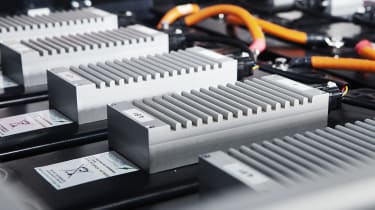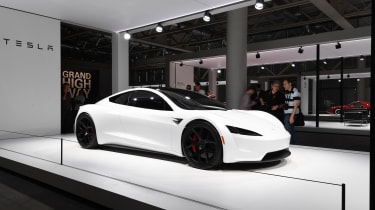How Tesla can get a 600-mile range from the new Roadster
Dr Michael Whiteley of UCL's Advanced Propulsion Lab explains the science behind such a big jump in battery efficiency
Tesla has always blazed a trail for the electric technology and automotive industries, and it doesn’t seem to be applying the (regen) brakes any time soon.
Recent announcements from the brand have included the removal of retail forecourts in favour of online shopping, the planned introduction of the Model Y, and now news that the new Tesla Roadster will have a range of 600 miles or more from a 200kWh battery; double the energy and range of anything in the current model line-up.
From the initial Model S to the more recently launched Model 3, the highest-specification battery pack offered in a Tesla contained 100kWh of energy, giving a claimed range of around 300 miles on a full charge. However, in late 2018 it was announced that the new Roadster would be available with a 200kWh pack that would be good for a range of 600 miles.
This gargantuan increase in performance had me scratching my head. How is it possible to increase these values by 100%? It wouldn't be possible to simply squeeze two Model X battery packs into the Roadster due to the size and weight of them, so has the company invented a new battery chemistry, or is it a far simpler engineering solution?
Luckily, I work with a team of highly experienced electrochemical scientists and engineers at the University of London, and after a round of teas while scribbling on notepads, this is what we think is happening with the new Tesla Roadster pack.
From 18650 to 21700, and a 'can do' attitude
Since day one, Tesla has been using conventional lithium batteries that come in a package called an 18650 can. This codename relates to the dimensions of the can that contains the gubbins of a lithium cell. The diameter of the can is 18mm across, and the length is 65mm, making for its codename, 18650. These are normally connected in a specific order, both in series and parallel, to create a battery module. These modules are then connected to make a pack.
Although this has been a staple of Tesla automotive packs for some years now, Tesla – and the industry as a whole – is moving towards the 21700 cell can. You guessed it, that’s a bigger can, 21mm in diameter and 70mm long. The 21700 cell is 46% larger in volume and in the region of 15% more efficient than its 18650 counterpart, making it easier to design smaller modules (and therefore packs) with more energy.

This merely means that there's more energy in each cell, and the packaging of the entire battery pack can be engineered to remove dead space and wasted weight. This is exactly what Tesla did for the Model 3 pack, which is a smaller unit, but there's nothing stopping the company applying the same logic to the pack for the Roadster.
Chemical additives
Just changing the can, however, doesn't yield 100% improvements in headline figures. For this, we need to look elsewhere for help. Although we lump all modern batteries into the 'lithium' name, there are countless variations of the chemistry that make a lithium-ion battery.
The most common at the moment seems to be the Nickel Manganese Cobalt Oxide cell (NMC for short). Tesla is famed for using the Panasonic Nickel Cobalt Aluminium cathode chemistry (NCA); however, there are rumours that it's making the shift over to NMC for its 21700 cells, as it already has for the Powerwall and possibly the articulated truck project.
Changing the ratio of cobalt to nickel in the cathode, or adding things like silicon to the anode, can make for small gains in each area of the cell. So, not only does changing the basic chemistry bring small gains, but the additives that we use to improve cells is always changing.
One of the recent targets for manufacturers is to increase the voltage of the cathode of a cell, as the cathode is the limiting electrode in a battery. Currently, a cell can be charged to 4.2 volts, but if we could increase the cathode voltage to, say, 5 volts, the overall energy density of the cell would improve.
Multiply that over the entire pack, and you have a nice little gain in performance. High-voltage cathodes require high-voltage electrolytes, containing proprietary additives in highly protected and innovative mixtures.
So, how did Tesla do it?
Well, we don't have a direct line to Elon and he'd be unlikely to tell us for sure if we did. But all of the evidence is pointing towards small tweaks in chemistry and pack engineering to get that magic increase in performance.

The change from 18650 to 21700 cans would allow for the re-engineering of the pack to contain less packaging, and more chemistry, making the volumetric energy density increase.
Partner that with the great work that scientists at Panasonic and Tesla are doing with additives and electrode thinning, and you have a recipe for a dramatic increase in pack performance without having to reinvent the wheel (or battery in this case).
Hats off to Tesla, though. The bastions for electrification are constantly pushing the envelope of what’s possible, and I for one am looking forward to seeing what they come up with next.

About the author
Dr. Michael Whiteley is an experienced scientist in the areas of electrochemical energy storage and hybrid/electric propulsion systems. He was the Head of Fuel Cell Engineering at University College London (UCL), before becoming the Director of Strategic Alliance at the university's state-of-the-art Advanced Propulsion Lab.
Most Popular

EV Deal of the Day: Dacia Spring is amazingly good value at £116 per month


